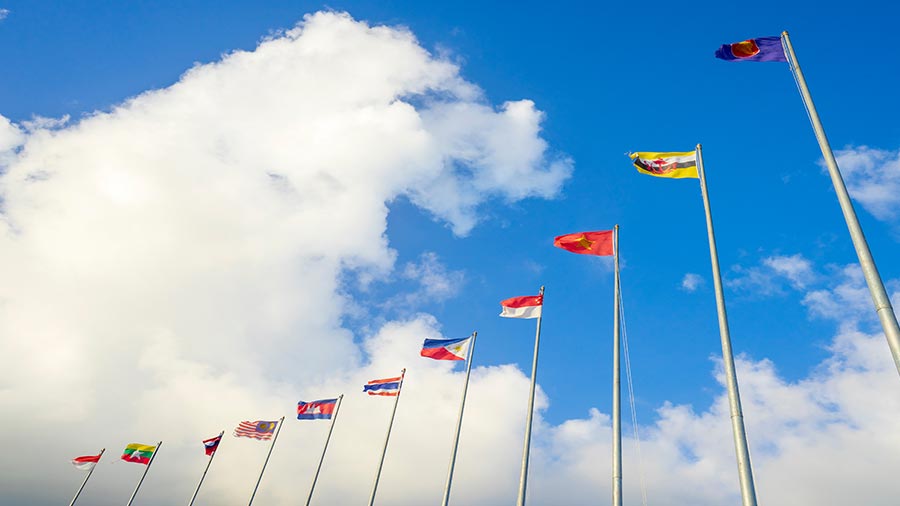China
Did Taiwan’s president send women to entertain British officials?

A video of two scantily-clad women dancing around a man has been shared in Chinese-language posts with a claim that they were sent by Taiwan’s President Tsai Ing-wen to entertain members of the British Conservative Party during their visit to Taiwan.
The claim is false. The video shows a Taiwanese company party around the beginning of the 2023 Chinese New Year. A review of all official British dignitaries to Taiwan over the past two years also did not reveal any person who matched the man in the video.
The video was shared on X, formerly known as Twitter, on Jan. 3.
“President Tsai sent a Taiwanese girl to the political reception of the British Conservative Party! The girl tried her best to provide service with a dedicated mind, but she has not been able to get a promotion yet. So she got angry and complained on X. She is also ready to go to Beijing to complain about Tasi,” reads the claim.
The one-minute and 14-second clip shows two women dancing around a man at what appears to be a banquet.
The identical video with similar claims has also been shared on Telegram.
But the claim is false.
Courier’s New Year’s party
A reverse image search on Google found the footage first appeared in a post by the X account “CEO Briefing” on Jan. 9, 2023.
“I never thought Chinese girls could be so bold! A shipping company’s end of the year dinner party. There’ll also be a get together after Chinese New Year,” the caption reads.
At around the 40-second point in the video, the traditional Chinese characters for “Tongda” are visible on a wall, a style predominantly used in Taiwan. Additionally, a careful examination of the clip shows that the people are speaking Mandarin with a Taiwanese accent, suggesting that the event occurred in Taiwan.
Keyword searches found a Taiwanese company called Tongda Express.
An image from Google Map shows the company’s brand name printed across the body of one of its vehicles. Both the font and color of the word Tongda on the vehicle appear to match the same characters on the wall in the video.
The Taiwanese media outlet MinTV News also reported on the video, saying that the event took place at a Chinese New Year’s party.

Tsai’s meetings with British officials
A review of press releases of President Tsai’s meetings with U.K. officials over the past two years shows that none of them match the man shown in the video of the dancing girls.
They include meetings with Minister of State for Trade Policy Greg Hands in November 2022, members of the British-Taiwanese All-Party Parliamentary Group in March 2023 and Deputy Speaker of the House of Lords and U.K. Trade Envoy to Taiwan Lord Faulkner of Worcester in September 2023.
Tongda Express has not responded to questions about the video as of press time.
Translated by Shen Ke. Edited by Taejun Kang and Malcolm Foster.
Asia Fact Check Lab (AFCL) was established to counter disinformation in today’s complex media environment. We publish fact-checks, media-watches and in-depth reports that aim to sharpen and deepen our readers’ understanding of current affairs and public issues. If you like our content, you can also follow us on Facebook, Instagram and X.
Read the rest of this article here >>> Did Taiwan’s president send women to entertain British officials?
Business
Gordonstoun Severs Connections with Business Led by Individual Accused of Espionage for China

Gordonstoun school severed ties with Hampton Group over espionage allegations against chairman Yang Tengbo. He denies involvement and claims to be a victim of political tensions between the UK and China.
Allegations Lead to School’s Decision
Gordonstoun School in Moray has cut ties with Hampton Group International after serious allegations surfaced regarding its chairman, Yang Tengbo, who is accused of being a spy for the Chinese government. Known by the alias "H6," Mr. Tengbo was involved in a deal that aimed to establish five new schools in China affiliated with Gordonstoun. However, the recent allegations compelled the school to terminate their agreement.
Public Denial and Legal Action
In response to the spying claims, Mr. Tengbo publicly revealed his identity, asserting that he has committed no wrongdoing. A close associate of Prince Andrew and a former Gordonstoun student himself, Mr. Tengbo has strenuously denied the accusations, stating that he is a target of the escalating tensions between the UK and China. He has claimed that his mistreatment is politically motivated.
Immigration Challenges and Legal Responses
Yang Tengbo, also known as Chris Yang, has faced additional challenges regarding his immigration status in the UK. After losing an appeal against a ban enacted last year, he reiterated his innocence, condemning media speculation while emphasizing his commitment to clear his name. Gordonstoun, on its part, stated its inability to divulge further details due to legal constraints.
Source : Gordonstoun cuts ties with business chaired by man accused of spying for China
Business
China Dismantles Prominent Uyghur Business Landmark in Xinjiang – Shia Waves

The Chinese government demolished the Rebiya Kadeer Trade Center in Xinjiang, affecting Uyghur culture and commerce, prompting criticism from activists amid concerns over cultural erasure and human rights violations.
Demolition of a Cultural Landmark
The Chinese government recently demolished the Rebiya Kadeer Trade Center in Urumqi, Xinjiang, a vital hub for Uyghur culture and commerce, as reported by VOA. This center, once inhabited by more than 800 predominantly Uyghur-owned businesses, has been deserted since 2009. Authorities forcibly ordered local business owners to vacate the premises before proceeding with the demolition, which took place without any public notice.
Condemnation from Activists
Uyghur rights activists have condemned this demolition, perceiving it as part of China’s broader strategy to undermine Uyghur identity and heritage. The event has sparked heightened international concern regarding China’s policies in Xinjiang, which have been characterized by allegations of mass detentions and cultural suppression, prompting claims of crimes against humanity.
Rebiya Kadeer’s Response
Rebiya Kadeer, the center’s namesake and a notable Uyghur rights advocate, criticized the demolition as a deliberate attempt to erase her legacy. Kadeer, who has been living in exile in the U.S. since her release from imprisonment in 2005, continues to advocate for Uyghur rights. She has expressed that her family members have suffered persecution due to her activism, while the Chinese government has yet to comment on the legal ramifications of the demolition.
Source : China Demolishes Uyghur Business Landmark in Xinjiang – Shia Waves
China
China Expands Nationwide Private Pension Scheme After Two-Year Pilot Program

China’s private pension scheme, previously piloted in 36 cities, will roll out nationwide on December 15, 2024, enabling workers to open tax-deferred accounts. The initiative aims to enhance retirement savings, address aging population challenges, and stimulate financial sector growth.
After a two-year pilot program, China has officially expanded its private pension scheme nationwide. Starting December 15, 2024, workers covered by urban employee basic pension insurance or urban-rural resident basic pension insurance across the country can participate in this supplementary pension scheme. This nationwide rollout represents a significant milestone in China’s efforts to build a comprehensive pension system, addressing the challenges of a rapidly aging population.
On December 12, 2024, the Ministry of Human Resources and Social Security, together with four other departments including the Ministry of Finance, the State Taxation Administration, the Financial Regulatory Administration, and the China Securities Regulatory Commission, announced the nationwide implementation of China’s private pension scheme effective December 15, 2024. The initiative extends eligibility to all workers enrolled in urban employee basic pension insurance or urban-rural resident basic pension insurance.
A notable development is the expansion of tax incentives for private pensions, previously limited to pilot cities, to a national scale. Participants can now enjoy these benefits across China, with government agencies collaborating to ensure seamless implementation and to encourage broad participation through these enhanced incentives.
China first introduced its private pension scheme in November 2022 as a pilot program covering 36 cities and regions, including major hubs like Beijing, Shanghai, Guangzhou, Xi’an, and Chengdu. Under the program, individuals were allowed to open tax-deferred private pension accounts, contributing up to RMB 12,000 (approximately $1,654) annually to invest in a range of retirement products such as bank deposits, mutual funds, commercial pension insurance, and wealth management products.
Read more about China’s private pension pilot program launched two years ago: China Officially Launches New Private Pension Scheme – Who Can Take Part?
The nationwide implementation underscores the Chinese government’s commitment to addressing demographic challenges and promoting economic resilience. By providing tax advantages and expanding access, the scheme aims to incentivize long-term savings and foster greater participation in personal retirement planning.
The reform is expected to catalyze growth in China’s financial and insurance sectors while offering individuals a reliable mechanism to enhance their retirement security.
| This article was first published by China Briefing , which is produced by Dezan Shira & Associates. The firm assists foreign investors throughout Asia from offices across the world, including in in China, Hong Kong, Vietnam, Singapore, and India . Readers may write to info@dezshira.com for more support. |
Read the rest of the original article.






